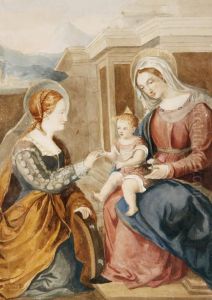Lady Anne Barnard Paintings
Lady Anne Barnard was a Scottish travel writer, artist, and socialite of the 18th and 19th centuries. Born on December 12, 1750, in Balcarres House, Fife, Scotland, she was the eldest daughter of James Lindsay, 5th Earl of Balcarres, and his wife Anne Dalrymple. Her family was part of the aristocracy, which allowed her to receive an education that included the arts and literature, something not all women of her time had access to.
Lady Anne is best known for her letters and diaries, which provide a vivid account of her life and the social and political scenes of her time. In 1793, she married Andrew Barnard, the son of the Bishop of Limerick, and in 1797, they moved to the Cape of Good Hope in South Africa, where Andrew became Colonial Secretary. Her experiences in South Africa led to the creation of a series of letters and journals that offer valuable insights into colonial life and the British Empire's expansion.
Apart from her writing, Lady Anne was also an accomplished artist. She created a number of sketches and watercolors that depicted the landscapes and peoples of South Africa, which were some of the earliest representations of the region by a European artist. Her works are appreciated for their historical value as well as their artistic merit.
In addition to her artistic pursuits, Lady Anne was known for her role in the social circles of her time. She hosted many gatherings and was well-connected with influential figures of the era, including the British royal family. Her Cape Town residence, known as The Vineyard, became a social hub for the colony's elite and visiting dignitaries.
Lady Anne's husband, Andrew Barnard, died in 1807, and she returned to Britain in 1808. She continued to write and engage with cultural and social activities until her death on May 6, 1825. Although not widely known today, Lady Anne Barnard's contributions to literature, art, and society provide a unique perspective on the late 18th and early 19th centuries, particularly in the context of British colonial history.
